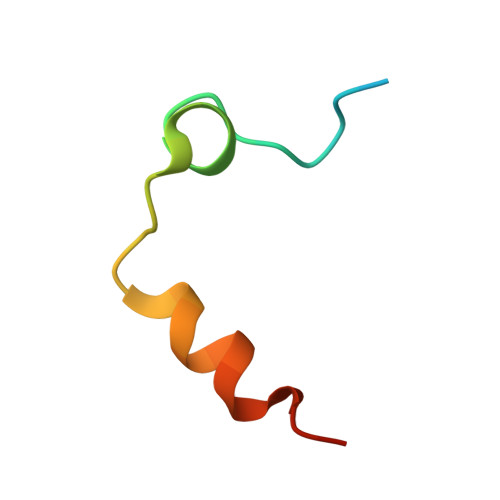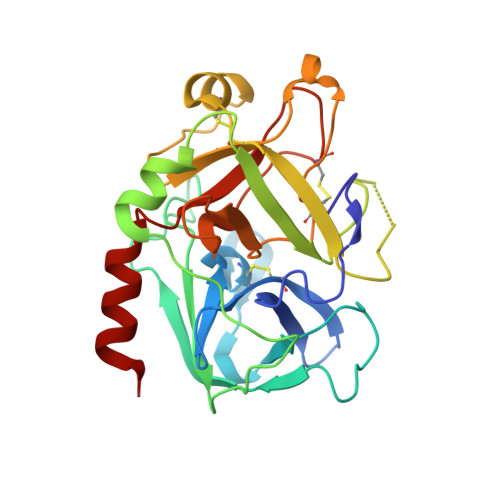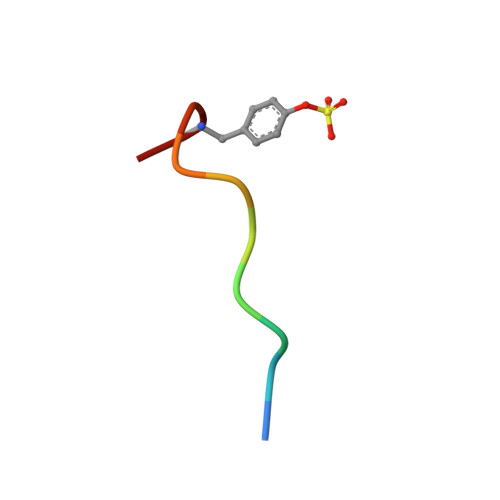The Determination of Protonation States in Proteins.
Ahmed, H.U., Blakeley, M.P., Cianci, M., Cruickshank, D.W.J., Hubbard, J.A., Helliwell, J.R.(2007) Acta Crystallogr D Biol Crystallogr 63: 906
- PubMed: 17642517
- DOI: https://doi.org/10.1107/S0907444907029976
- Primary Citation of Related Structures:
2UU8, 2UUF, 2UUJ, 2UUK, 2YZ4 - PubMed Abstract:
The protonation states of aspartic acids and glutamic acids as well as histidine are investigated in four X-ray cases: Ni,Ca concanavalin A at 0.94 A, a thrombin-hirugen binary complex at 1.26 A resolution and two thrombin-hirugen-inhibitor ternary complexes at 1.32 and 1.39 A resolution. The truncation of the Ni,Ca concanavalin A data at various test resolutions between 0.94 and 1.50 A provided a test comparator for the ;unknown' thrombin-hirugen carboxylate bond lengths. The protonation states of aspartic acids and glutamic acids can be determined (on the basis of convincing evidence) even to the modest resolution of 1.20 A as exemplified by our X-ray crystal structure refinements of Ni and Mn concanavalin A and also as indicated in the 1.26 A structure of thrombin, both of which are reported here. The protonation-state indication of an Asp or a Glu is valid provided that the following criteria are met (in order of importance). (i) The acidic residue must have a single occupancy. (ii) Anisotropic refinement at a minimum diffraction resolution of 1.20 A (X-ray data-to-parameter ratio of approximately 3.5:1) is required. (iii) Both of the bond lengths must agree with the expectation (i.e. dictionary values), thus allowing some relaxation of the bond-distance standard uncertainties required to approximately 0.025 A for a '3sigma' determination or approximately 0.04 A for a '2sigma' determination, although some variation of the expected bond-distance values must be allowed according to the microenvironment of the hydrogen of interest. (iv) Although the F(o) - F(c) map peaks are most likely to be unreliable at the resolution range around 1.20 A, if admitted as evidence the peak at the hydrogen position must be greater than or equal to 2.5 sigma and in the correct geometry. (v) The atomic B factors need to be less than 10 A(2) for bond-length differentiation; furthermore, the C=O bond can also be expected to be observed with continuous 2F(o) - F(c) electron density and the C-OH bond with discontinuous electron density provided that the atomic B factors are less than approximately 20 A(2) and the contour level is increased. The final decisive option is to carry out more than one experiment, e.g. multiple X-ray crystallography experiments and ideally neutron crystallography. The complementary technique of neutron protein crystallography has provided evidence of the protonation states of histidine and acidic residues in concanavalin A and also the correct orientations of asparagine and glutamine side chains. Again, the truncation of the neutron data at various test resolutions between 2.5 and 3.0 A, even 3.25 and 3.75 A resolution, examines the limits of the neutron probe. These various studies indicate a widening of the scope of both X-ray and neutron probes in certain circumstances to elucidate the protonation states in proteins.
Organizational Affiliation:
School of Chemistry, Brunswick Street, The University of Manchester, Manchester, England.




















